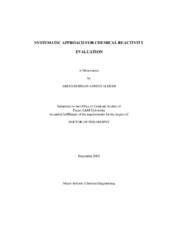| dc.description.abstract | Under certain conditions, reactive chemicals may proceed into uncontrolled chemical reaction pathways with rapid and significant increases in temperature, pressure, and/or gas evolution. Reactive chemicals have been involved in many industrial incidents, and have harmed people, property, and the environment. Evaluation of reactive chemical hazards is critical to design and operate safer chemical plant processes. Much effort is needed for experimental techniques, mainly calorimetric analysis, to measure thermal reactivity of chemical systems. Studying all the various reaction pathways experimentally however is very expensive and time consuming. Therefore, it is essential to employ simplified screening tools and other methods to reduce the number of experiments and to identify the most energetic pathways. A systematic approach is presented for the evaluation of reactive chemical hazards. This approach is based on a combination of computational methods, correlations, and experimental thermal analysis techniques. The presented approach will help to focus the experimental work to the most hazardous reaction scenarios with a better understanding of the reactive system chemistry. Computational methods are used to predict reaction stoichiometries, thermodynamics, and kinetics, which then are used to exclude thermodynamically infeasible and non-hazardous reaction pathways. Computational methods included: (1) molecular group contribution methods, (2) computational quantum chemistry methods, and (3) correlations based on thermodynamic-energy relationships. The experimental techniques are used to evaluate the most energetic systems for more accurate thermodynamic and kinetics parameters, or to replace inadequate numerical methods. The Reactive System Screening Tool (RSST) and the Automatic Pressure Tracking Adiabatic Calorimeter (APTAC) were employed to evaluate the reactive systems experimentally. The RSST detected exothermic behavior and measured the overall liberated energy. The APTAC simulated near-adiabatic runaway scenarios for more accurate thermodynamic and kinetic parameters. The validity of this approach was investigated through the evaluation of potentially hazardous reactive systems, including decomposition of di-tert-butyl peroxide, copolymerization of styrene-acrylonitrile, and polymerization of 1,3-butadiene. | en |


